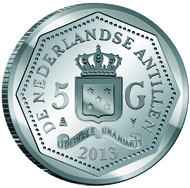August 1, 2013 – In the 17th century the Dutch slave trade was in the hands of the Dutch East India Company and the West India Company. Slaves were forced to work on sugar, coffee, cocoa, cotton and tobacco plantations. They worked in the salt ponds of Curaçao or served their masters.
There was also rebellion, the largest of which took place in 1795 in Curaçao led by Tula. He did not survive the rebellion. At the end of the 18th century, the outrage on the subject slave trading was rising. The Law on the Abolition of Slavery was passed in 1862 and on July 1, 1863 the slaves originating from West Africa living in the colony of Suriname and the Netherlands Antilles finally obtained their freedom.
Curaçao and Sint Maarten / 5 Guilders / 925 silver / 11.9g / 29mm / Mintage: 750.
On that occasion the Koninklijke Nederlandse Munt has struck on behalf of Curaçao and Sint Maarten a 5 Guilders silver coin. The coin shows on the obverse the coat of arms of the Netherlands Antilles, the nominal value and the year of issue.
On the reverse slaves are depicted in the act of destroying their chains with the inscription ‘150 Years of Freedom 1863-2013, De kettenen verbroken’ (Break the Shackles).
For more information visit the website of the Koninklijke Nederlandse Munt.
Here you can see a list of former commemorative coins issued by the Central Bank of Curaçao and Sint Maarten.






